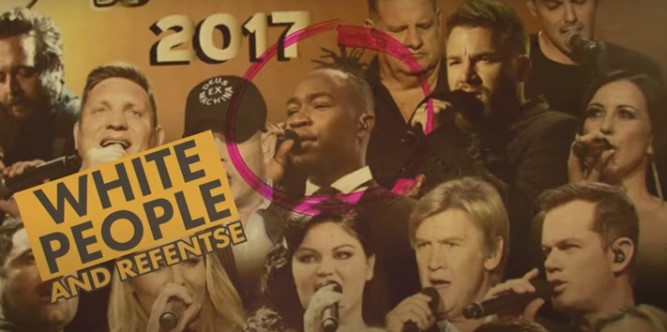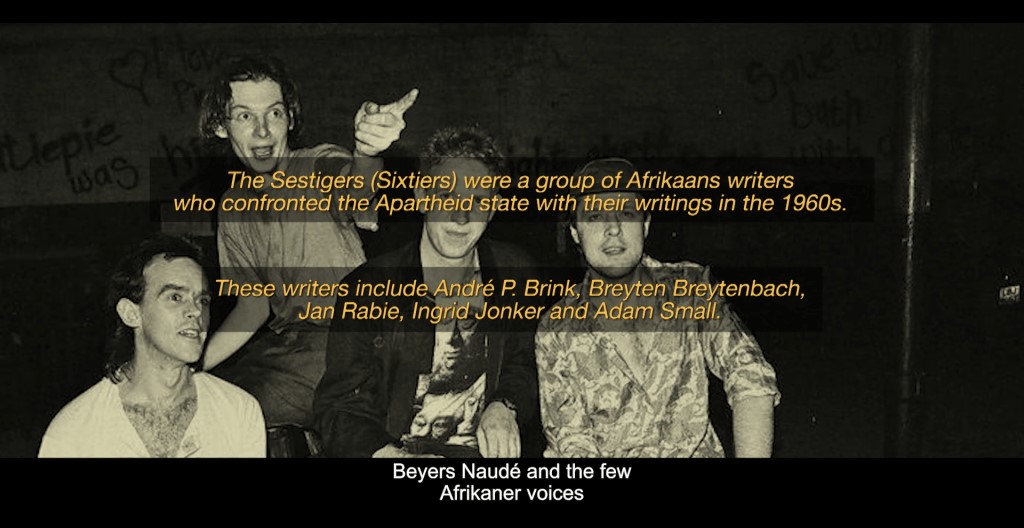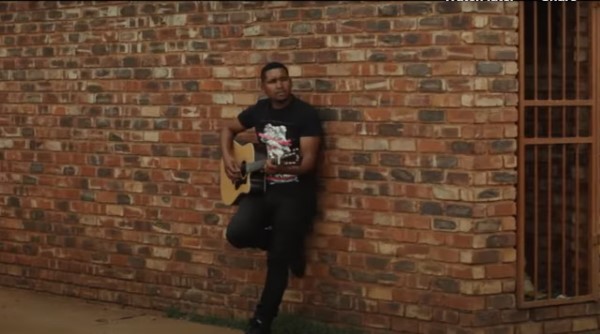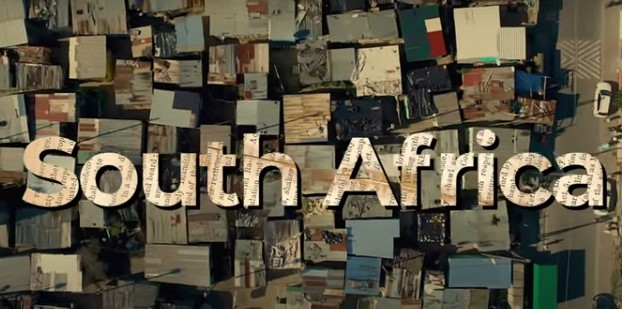Director: Gideon Breytenbach & Riku Lätti. Writer: Gideon Breytenbach & Jackie Lätti. Running time: 1hr 38 mins. The power, and limitations, of culture as a force for change are have long been debated by a left that has found its influence waning throughout the last century.
 Jack Benjamin / Indy Film Library*
Jack Benjamin / Indy Film Library*
“The voice behind the wall” is an impressive piece of work, which manages to sum up the trappings of under or overestimating the power of culture through a complex portrait of the Afrikaans music scene throughout the last century – what it helped to change, and where it failed. Afrikaans is what is described by the film as “creole” language – a language which develops from the process of different languages simplifying and mixing into a new form. Afrikaans initially grew out of the Dutch Cape Colony in South Africa, where the slaves picked up the language of their masters – their language having already started to develop separately from the Dutch spoken in Europe – simplifying it, and blending it with other tongues.
Afrikaans gradually developed distinct characteristics from Dutch over the 18th century, with influxes of other cultures including colonisers from France, Germany and the United Kingdom. With South Africa obtaining sovereignty in 1934, Afrikaans soon became a site of struggle, to determine what the identity of the country would be.
The early segments of Gideon Breytenbach and Riku Lätti’s documentary subsequently charts the initial ways in which Afrikaans embodied a very different potential to the one that would manifest soon after – through the birth of a distinct musical identity.
 Afrikaans music, also known as boerenmusiek evolved from a mix of many different influences – European, American, African, all informed by Afrikaans lyrics, every song guided by the need for the distinct cadence and rhythm of any language to shape beats and melodies around it. The talking heads Breytenbach and Lätti have assembled are excellent at explaining how all of this came together, to the extent that even someone with all the musical talent of a block of wood like myself can see how everything fits into place.
Afrikaans music, also known as boerenmusiek evolved from a mix of many different influences – European, American, African, all informed by Afrikaans lyrics, every song guided by the need for the distinct cadence and rhythm of any language to shape beats and melodies around it. The talking heads Breytenbach and Lätti have assembled are excellent at explaining how all of this came together, to the extent that even someone with all the musical talent of a block of wood like myself can see how everything fits into place.
Sadly, an inescapable historic moment is approaching. In 1948, a decade after boerenmusiek came to prominence, the white nationalist party Natte rose to power. Suddenly, a language and a form of music which implied any kind of shared culture with different ethnicities was seen as a problem to the governing elites, as it undermined the brutal regime of apartheid that they were bent on implementing and normalising. Afrikaans became a battleground, with the country’s white minority dogmatically policing how Afrikaans should be spoken, and making a concerted effort to reshape Afrikaans music in that image.
The guests discuss what they were taught in school at that time, what they were allowed to hear on the radio or read in the newspaper, and gradually they also describe the creeping suspicion that they were being lied to. Most of this was born from the conspicuous lack of authenticity in the sweet nothings of the endless “Schlager shit” and love ballads that the experts recall mainstream culture was feeding them, amid an increasingly hostile society.
 And when they began to look at why that was, it helped them explore the origins of Afrikaans as a language, increasingly realising these were not solely white in a country where whites had a divine right to rule – but that its existence was a legacy of colonialism, theft and bloodshed – but also of shared space and cultural integration.
And when they began to look at why that was, it helped them explore the origins of Afrikaans as a language, increasingly realising these were not solely white in a country where whites had a divine right to rule – but that its existence was a legacy of colonialism, theft and bloodshed – but also of shared space and cultural integration.
The film then becomes a collective recollection of cultural rebellion, taking place in the 1980s and early 90s. Looking to uncover the true nature of Afrikaans and the music it helped to found, as a means to undermine apartheid, a new generation of musicians fought to be heard, in spite of state and media censorship, and the threat of violence. In a whirlwind 20-minutes, new waves of Afrikaans music rise to popularity, and carry hordes of impassioned fans with them – first swept up in the fact they were hearing something that was raw, genuine and catchy, before exploring the meanings behind the songs and lyrics; and encountering like-minded people at gigs, realising another South Africa was possible.
As fascinating (and eerily reminiscent of the current political and cultural discourse around Palestine) as this is, however, it is a lot to take in. It is here “The voice behind the wall” encounters its biggest and most persistent problem. I’m not any kind of authority on South African history, but I know enough to more or less be able to place the things being discussed on a timeline. This will not be the case for everyone in the international audience – and with the film entirely subtitled in English, with English title cards feeding us extra information, that seems to be an audience that the film is definitely trying to court.
 As a result, some of the power or impact of the music and movement in relation to ending apartheid will probably be lost.
As a result, some of the power or impact of the music and movement in relation to ending apartheid will probably be lost.
In some ways, the film seems to be aware with this, and has tried to compensate with the aforementioned title cards – each one stuffed with relevant factoids to the relevant historical moment. But this won’t work well for anyone without access to a pause-button. My Dutch is abominable, so while there were a few shared terms I recognised in Afrikaans, I spent most of my time with my eyes glued to the subtitles to understand what those being interviewed were saying. At the same time, large amounts of information about the practicalities of apartheid, identities of its architects, stories of those who opposed it, or statistics about its legacy flashed across the screen. I could only catch up by stopping the movie – and in a cinema, this is unlikely to be viable for viewers who want to know more.
Some of this may be because the film has scarcely even introduced the man who seems to be its true subject: Churchil Naudé. Having initially encountered him in some endearingly sweary vignettes about how legal apartheid ended, but economic segregation is still in full swing, he takes a back seat until the film’s historical overview of Afrikaans and Afrikaans music reaches the modern day.
Naudé is a speaker of Afrikaans, and is bemused by increasing laments in the country that the language is dying out. There are more than six million speakers of the language, after all.
 Not-so-coincidentally, though, just over 2 million of those are white people. As is the case in the UK, France, and too many other countries where ‘concerned citizens’ publicly decry the supposed deterioration of a language and culture, this is not about how many people are speaking the language, but how many people are speaking the rigidly policed ‘correct’ version defined and controlled by white people. Describing himself as “brown”, Naudé correctly contends that his version of Afrikaans is just as valid as any other – and has launched a music career of his own. Backed by an assortment of musicians who were involved in the earlier fight for the soul of Afrikaans music, he delivers angry spoken-word and hip-hop-infused lyrics over a fabulously eclectic backing track – skewering the continued legacy of apartheid, while arguing for a future worth fighting for.
Not-so-coincidentally, though, just over 2 million of those are white people. As is the case in the UK, France, and too many other countries where ‘concerned citizens’ publicly decry the supposed deterioration of a language and culture, this is not about how many people are speaking the language, but how many people are speaking the rigidly policed ‘correct’ version defined and controlled by white people. Describing himself as “brown”, Naudé correctly contends that his version of Afrikaans is just as valid as any other – and has launched a music career of his own. Backed by an assortment of musicians who were involved in the earlier fight for the soul of Afrikaans music, he delivers angry spoken-word and hip-hop-infused lyrics over a fabulously eclectic backing track – skewering the continued legacy of apartheid, while arguing for a future worth fighting for.
With a market still dominated and controlled by white interests – many of whom have made an overt political project of claiming a narrow form of Afrikaans for their own (something right-wing country singers are accustomed to doing with the blues-influenced music they have bastardised for their own ends), this looks to be an uphill struggle. I can only hope that “The voice behind the wall” helps acquaint a new audience with Naudé’s work, as it did for me. Not only is he the most captivating presence in the film – which considering the calibre of talking heads here is a grand achievement – but his first album Kroesifaaid is well worth a listen. Tracks My Wereld and Die Blood – both featured in this film’s soundtracks – are towering achievements in particular.
 Overall grade
Overall grade
All in all, “The voice behind the wall” feels like it could be two, or even three films, rather than one. Honestly, I love every one of them, but I don’t know if they always work well together. At times, each of those films finds itself fighting with the others for enough time and space to be properly heard and absorbed. But I would be reluctant to separate any of them. We get a grand, sweeping view of South African history, before focusing on the material implications of that history for one person – still determined to change it for the better. Perhaps it would work better with a longer run-time – hellish as that might sound to its editors, or to festivals trying to programme it – giving every aspect a little more room to shine (and meaning I would come away from it feeling a little less like I just sat an A-level reading exam).
*Article originally published in Indy Film Library.
(Photos: Indy Media Film & trailer)












.jpg)












